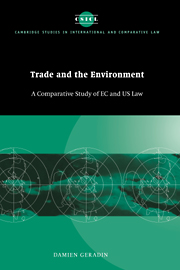Book contents
- Frontmatter
- Contents
- Preface
- Table of cases
- Table of legislation
- List of abbreviations
- Introduction
- PART 1 NEGATIVE HARMONIZATION
- 1 The case law of the Court of Justice
- 2 The case law of the Supreme Court
- 3 Comparative analysis
- 4 Judicial and legislative intervention
- PART 2 POSITIVE HARMONIZATION
- Conclusion
- Bibliography
- Index
- CAMBRIDGE STUDIES IN INTERNATIONAL AND COMPARATIVE LAW
4 - Judicial and legislative intervention
Published online by Cambridge University Press: 29 September 2009
- Frontmatter
- Contents
- Preface
- Table of cases
- Table of legislation
- List of abbreviations
- Introduction
- PART 1 NEGATIVE HARMONIZATION
- 1 The case law of the Court of Justice
- 2 The case law of the Supreme Court
- 3 Comparative analysis
- 4 Judicial and legislative intervention
- PART 2 POSITIVE HARMONIZATION
- Conclusion
- Bibliography
- Index
- CAMBRIDGE STUDIES IN INTERNATIONAL AND COMPARATIVE LAW
Summary
The previous chapters examined how the Court of Justice and the Supreme Court have attempted to deal with the various kinds of tension that may arise between trade and environmental protection through a process of selective invalidation of state environmental measures restricting trade. In order to bridge the two central parts of this study, the objective of this chapter is to discuss to what extent judicial intervention can be complemented by centralized legislative action taking the form of harmonization of state environmental standards.
Of all areas of environmental regulation, it is perhaps in the area of process standards that there is the most obvious need for the adoption of positive rules of harmonization. As we have seen, variations in the level of stringency of state environmental process standards may create distortions of competition between states. However, the traditional free-movement-of-goods case law of the Court of Justice and the Supreme Court appears to offer little protection to states whose industrial competitiveness is harmed by other states' lax process standards. Although the adoption by one state of lax process standards may generate distortions of competition, lax process standards do not in themselves generate the kind of barriers to trade susceptible of falling within the scope of Article 30 of the Treaty or of the dormant Commerce Clause doctrine.
- Type
- Chapter
- Information
- Trade and the EnvironmentA Comparative Study of EC and US Law, pp. 67 - 72Publisher: Cambridge University PressPrint publication year: 1997



